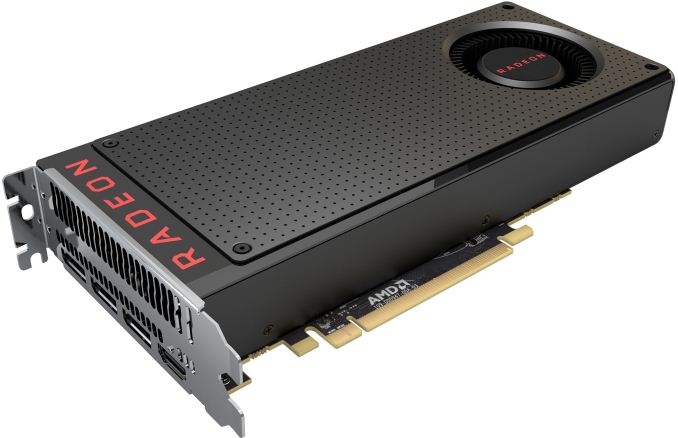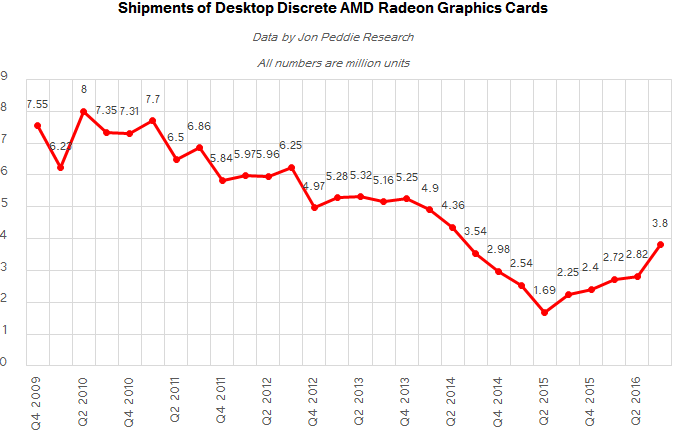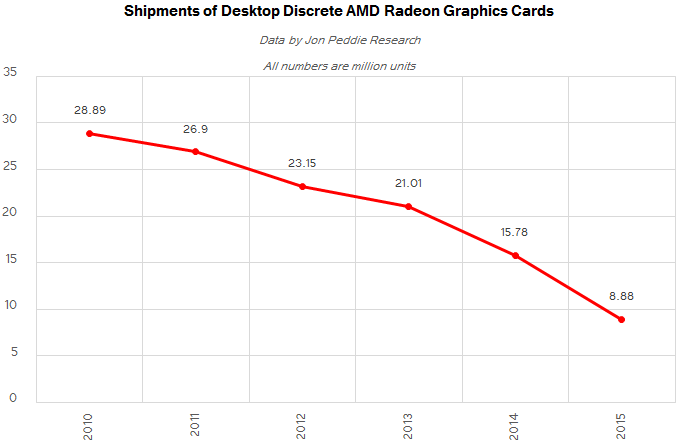Discrete Desktop GPU Market Trends Q3 2016: GPU Shipments Hit Two-Year High
by Anton Shilov on November 28, 2016 9:00 AM ESTAMD: Polaris Now Accounts for 50% of Channel GPU Revenue
Shipments of AMD’s GPUs (both standalone and integrated) were strong in Q3 2016: sales of desktop GPUs were up 34.7% QoQ, shipments of mobile GPUs were up 23% sequentially, supplies of desktop APUs decreased by 10% from the previous quarter and sales of mobile APUs grew by 19.1% QoQ, according to Jon Peddie Research. Overall, AMD’s PC graphics shipments increase by 15.4% from the previous quarter, JPR reports.
AMD does not disclose a lot of information about its GPU shipments. However, in its recent conference call the company confirmed that its quarterly channel GPU revenue and ASP in Q3 hit record levels since early 2014 and that the Radeon RX accounted for more than 50% of its channel GPU revenue. Furthermore, AMD said that its professional GPU revenue increased for the fourth consecutive quarter.
“The launch of our expanded family of Polaris desktop GPUs and our first full quarter of RX 480 sales drove our highest quarterly channel GPU revenue and ASP since early 2014,” said Lisa Su, CEO of AMD, during the conference call with investors and financial analysts. “The Radeon RX GPUs now account for more than 50% of our channel GPU revenue.”
AMD admitted that early in Q3 it could not meet demand for its new products made using 14 nm FinFET (14LPP) process technology, but things got better later in the quarter. As PC makers roll out new systems featuring AMD’s Polaris and other chips in Q4, the company hopes to either maintain or even increase its GPU shipments this quarter.
“We are very happy with how Polaris ramped in Q3,” said Dr. Su. “The customer demand across all geographies was very strong. Q3 was primarily a channel-based quarter. […] In the early part of Q3, we actually had some supply constraints, given the customer demand, [but] we did catch up towards the end of the quarter. […] As we go into Q4, in addition to the channel partners continuing to ramp, you should expect some OEMs launching in Q4 more broadly.”
AMD’s sales of desktop discrete GPUs in total for 2016 (Q1 to Q3) have already hit 9.34 million units, which is more than 8.8 million desktop graphics processors the company shipped in 2015. It is unknown whether AMD manages to increase its desktop GPU sales in Q4 substantially over Q3 to actually beat its 2014 results (15.78 million), but it is clear that AMD’s desktop GPU business is performing better this year than it did in 2015.
From the market share point of view, it remains to be seen how well AMD will respond to challenges imposed by NVIDIA’s Pascal GPUs in the performance market segment (i.e., $100-$249). In Q3 the company had to compete against NVIDIA’s Pascal-based GeForce GTX 1070/1080 graphics cards using its products released in 2015 (Fiji) and 2013 (Hawaii). None of those chips are manufactured or supplied today, which is why we see that prices of the Radeon R9 Fury- and the Radeon R9 390-series graphics cards vary greatly (e.g., you can get a Fury X for $299.99 after $30 rebate, or you can get the same card for $799.95). Some of AMD’s partners attempt to get rid of older products, others believe that since there will be no more Fiji or Hawaii chips, they will be able to capitalize on short supply of AMD’s high-end GPUs in the fourth quarter. In the meantime, AMD itself is gearing up to launch its Greenland/Vega high-end GPU in 2017 and has no plans to ship more Fiji or Hawaii processors (at least in mass quantities for consumer graphics adapters).













53 Comments
View All Comments
Shadowmaster625 - Monday, November 28, 2016 - link
It's actually rather sad that discrete GPU sales are only up 10% vs a year ago when they had been sandbagging on 2011 process tech for 4 years. I would have expected 14nm/16nm to provide a larger boost to sales.lefty2 - Monday, November 28, 2016 - link
This is because no one is buying desktops anymore. All the top tech companies give there employees laptops, not desktops: http://www.techworm.net/2016/11/computerlaptop-big...TheinsanegamerN - Monday, November 28, 2016 - link
And the majority of those desktops were using integrated solutions, not dedicated ones. Business moving to laptops hasnt had that big of an impact.Sarah Terra - Tuesday, December 13, 2016 - link
The slower sales are because of this reason: Nvidia has been milking process and architures for abnormal periods in order to maximize profts. As such a 2-3 generation old GPU is usually still "good enough" for most poeple, much like how users clung to sandy bridge. Back in the day, if you had a 3 year old GPU you were left in the dust, upgrades were far more frequent and necessary to keep pace. Nvidia is eseentially monopolizing themselves to a smaller market share, more competition will boost sales.Atique786 - Friday, October 1, 2021 - link
This is a very informative and interesting article. I have enjoyed reading your post and have come to the conclusion that you are a professional writer.https://realrelaxmassagechairreview.com/
<a href="https://realrelaxmassagechairreview.com/">... Relax Massage Chairs</a>
<a href="https://realrelaxmassagechairreview.com/real-relax... Relax Massage Chair Review</a>
<a href="https://realrelaxmassagechairreview.com/real-relax... Relax 2020 Massage Chair</a>
OldManMcNasty - Thursday, December 8, 2016 - link
Our engineers get whatever they want, I have a SurFace Pro 4 but I also have a virtual workstation with a Nvidia vGPU. If you're not an engineer, you're given a virtual desktop or you can select an iPad.Amna - Monday, February 14, 2022 - link
I really like the blog.I have shared your site with many friends and family. It is always a pleasure to read.<a href="https://realrelaxmassagechairreview.com/real-relax... Real Relax Massage Chair</a>
nathanddrews - Monday, November 28, 2016 - link
Larger than 10%? Why would you expect that?DanNeely - Wednesday, November 30, 2016 - link
Steadily bigger died and more efficient 28nm designs kept the performance gains coming, despite the process lag there wasn't a correspondingly huge buildup of demand.BurntMyBacon - Thursday, December 1, 2016 - link
@Shadowmaster625: "It's actually rather sad that discrete GPU sales are only up 10% vs a year ago when they had been sandbagging on 2011 process tech for 4 years."You are making a perhaps faulty assumption that most people buying GPUs know or care what processes nodes do for the video card they are buying. In my estimation, more people are concerned with how much it costs and if it does what they want it to do. I don't suspect many of them track how new cards compare to the last gen products, much less the several generations back that they would need to know to be aware of the process node stall.